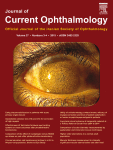Corneal elevation and keratoconus indices in a 40- to 64-year-old population, Shahroud Eye Study
Authors
Affiliations
1Noor Research Center for Ophthalmic Epidemiology, Noor Eye Hospital, Tehran, Iran.
2Lorestan University of Medical Sciences, Khorramabad, Iran.
3Noor Ophthalmology Research Center, Noor Eye Hospital, Tehran, Iran.
4Center for Health Related Social and Behavioral Sciences Research, Shahroud University of Medical Sciences, Shahroud, Iran.
5Department of Optometry, School of Paramedical Sciences, Mashhad University of Medical Sciences, Mashhad, Iran.
6Department of Community Medicine, School of Medicine, Tehran University of Medical Sciences, Tehran, Iran.
7Department of Epidemiology and Biostatistics, School of Public Health, Tehran University of Medical Sciences, Postal Box: 14155-6446, Tehran, Iran.
Abstract
Purpose: To determine the corneal elevation values and keratoconus indices in the 40- to 64-year-old population and their changes with aging.
Methods: The 6311 invitees of this study were selected through random cluster sampling, and 5190 of them participated in the study (response rate = 82.2%). Here, we analyzed results of Pentacam acquisitions in 4148 respondents. Cases of keratoconus and forme fruste keratoconus (FFKC) were determined using topography and clinical data. Studied variables included keratoconus indices, central corneal thickness readings, maximum elevations on the anterior and posterior surfaces, and elevation values at the thinnest point, anterior steepest point, and posterior steepest point in healthy, FFKC, and keratoconus groups.
Results: In all subjects, the mean maximum elevations were 6.80 ± 5.0 μm and 16.60 ± 7.7 μm on the anterior and posterior corneal surfaces, respectively. Maximum elevation values on the anterior and posterior corneal surfaces showed significant correlations in the keratoconus, FFKC, and healthy groups (P < 0.002). Maximum anterior elevation correlated with age (r = 0.11, P < 0.001), but maximum posterior elevation showed no such correlation (P = 0.476). Keratoconus indices demonstrated significant changes with age (P < 0.001).
Conclusion: Anterior elevation values slightly increase with age, and keratoconus indices change as well. Elevation readings and keratoconus indices in the keratoconus group and FFKC cases are higher than the healthy corneas although their values could be compared with other studies on younger participants.
Keywords: Corneal elevation; Pentacam; adult; cross-sectional study; keratoconus.

